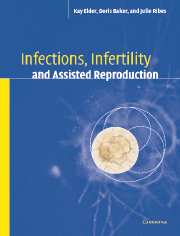Book contents
- Frontmatter
- Contents
- Foreword
- Preface
- Acknowledgements
- Part I Overview of microbiology
- Part II Infections in reproductive medicine
- Part III Infection and the assisted reproductive laboratory
- 13 Infection and contamination control in the ART laboratory
- 14 Handling infectious agents in the ART laboratory
- 15 Prevention: patient screening and the use of donor gametes
- Index
14 - Handling infectious agents in the ART laboratory
from Part III - Infection and the assisted reproductive laboratory
Published online by Cambridge University Press: 29 October 2009
- Frontmatter
- Contents
- Foreword
- Preface
- Acknowledgements
- Part I Overview of microbiology
- Part II Infections in reproductive medicine
- Part III Infection and the assisted reproductive laboratory
- 13 Infection and contamination control in the ART laboratory
- 14 Handling infectious agents in the ART laboratory
- 15 Prevention: patient screening and the use of donor gametes
- Index
Summary
Rigorous attention to maintaining a clean laboratory environment, a sterile culture microenvironment and aseptic technique at the interface of the two, should minimize exogenous contamination of gamete handling and culture systems in the ART laboratory. All human tissue and samples, regardless of prior testing for infectious agents, must be regarded as a potential hazard and handled accordingly. Samples identified as a biohazard after screening must be handled with extreme caution, according to specified protocols and procedures.
Blood-borne viruses
The blood-borne viruses (BBV), Hepatitis B, C, D and HIV are all potent pathogens capable of causing severe disease and death, with few effective treatments available. Nosocomial transmission of Hepatitis C has been reported (Lesourd et al., 2000, see below), and HBV transmission through contact with environmental surfaces has been demonstrated. The stability of HIV and HBV under different conditions has been determined experimentally.
HIV in high starting concentrations can remain infectious for 3 weeks or more in dried blood.
Infectious HIV can be detected for at least 2 months in liquid blood at room temperature.
HBV in dried plasma can retain infectivity for at least 4 months, and this is likely to be even longer in liquid blood or plasma.
Infectious HIV has been recovered from bodies up to 16 days after death, and it should be assumed that HBV is at least equally as robust.
- Type
- Chapter
- Information
- Infections, Infertility, and Assisted Reproduction , pp. 332 - 352Publisher: Cambridge University PressPrint publication year: 2004



